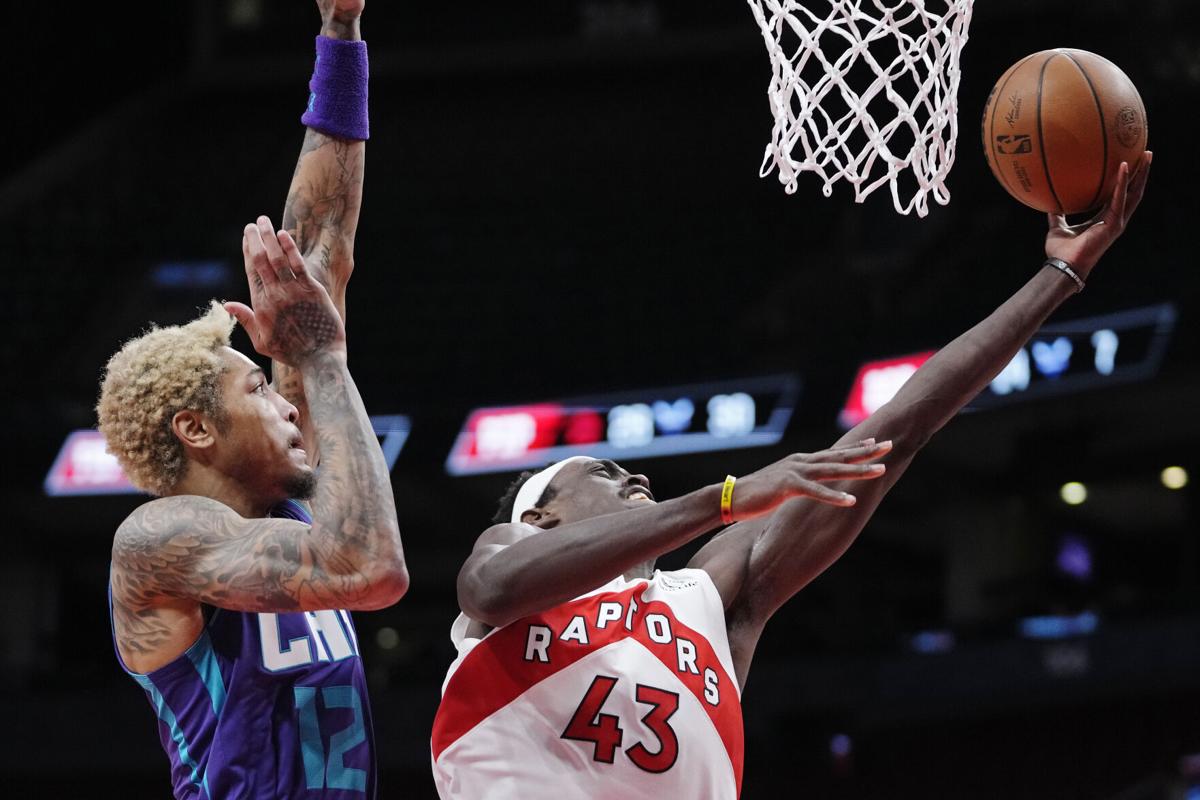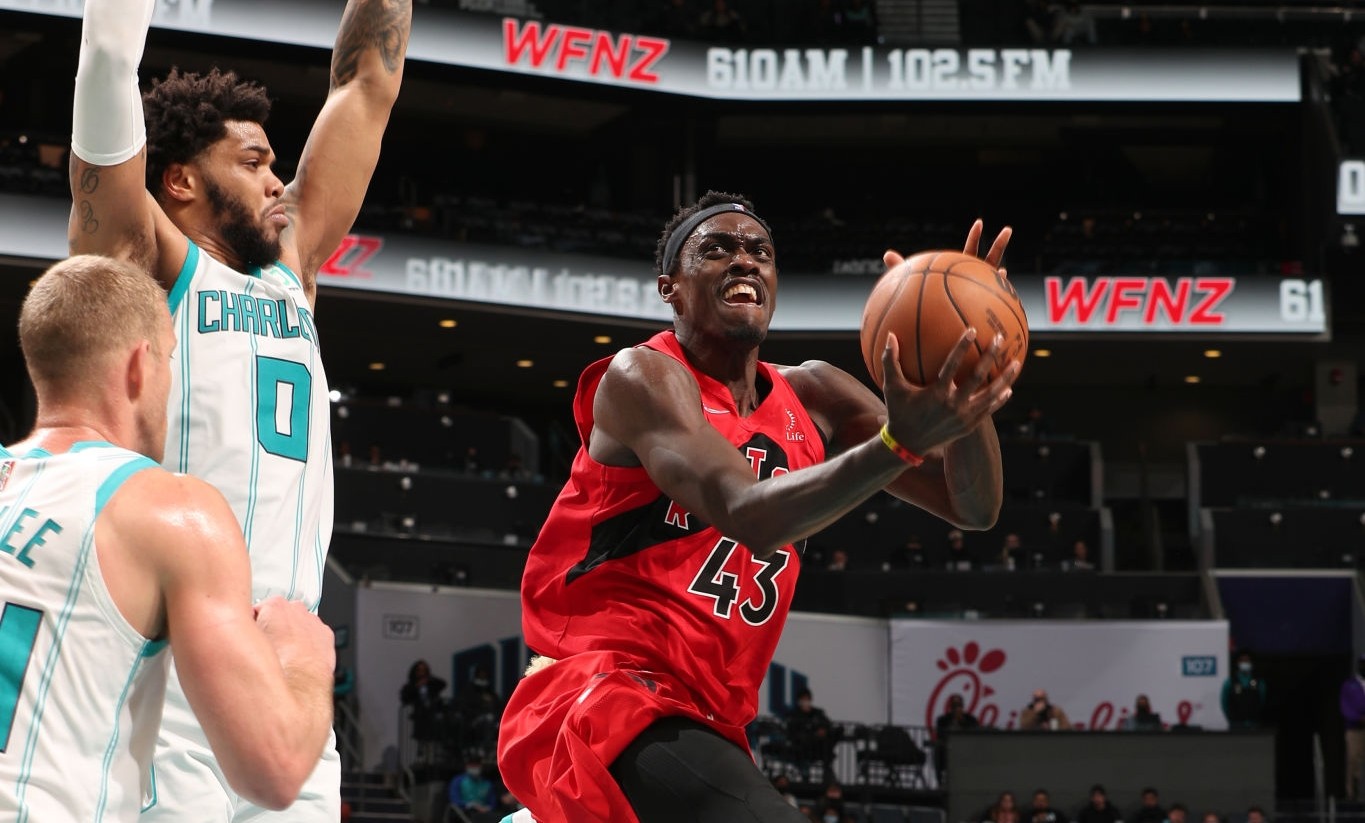It happened with a minute left in the doldrums of a blowout second quarter. The Charlotte Hornets were in the midst of a feeble comeback, playing what counted for them as passable defense. Pascal Siakam had other ideas. He caught the ball above the arc with Miles Bridges, a player with a defensive reputation, who can match his athleticism, facing him. Siakam drove right and took a hard dribble, then another, before turning to protect the ball. He probed towards the rim, dribbling with his left hand, leaning towards the hoop. Then, feeling Bridges’ weight shifting, giving way, Siakam pivoted and spun like a dreidel, whirling back to his right hand. He teleported from one step inside the free throw line to the rim in an instant, completely uncovered after the rapidity of his move. Layup.
For a player whose spin move was once his signature, his go-to move to reach the basket, Siakam went a long time without succeeding with the spin. For the majority of 2020-21, it seemed like Siakam’s spin move was solved like Nine Men’s Morris. Scouted.
“He kind of came into the league and it was kind of this cool thing he did,” said Nick Nurse after the game. “He would drive that thing and spin and be at the rim, and it was kind of just this thing that he had, right? That was kind of his thing. And I don’t know. I mean, it just seems like whatever happened there for a while, that didn’t seem to be a go-to move for him anymore. A lot of it I think has to do with just mindset, energy, open floor play, transition, our spacing, personnel on the floor, it could be a number of things, right, but I think it’s good to see him back in his groove.
“That [one against Bridges] was a quick one and kind of a throwback from the early days of Pascal.”
Like the spin move itself, Siakam’s game has come full circle. The difference between 2022 and 2018, of course, is that Siakam faced single coverage with his spins and twirls four years ago. He’s so long and strong and quick that unless a defender digs into his pocket and disrupts the ball, there’s not much of an opportunity to keep Siakam — who also has an enormous number of release points! — from getting to his spots on the spin for one individual. So he spun and laughed his way all the way to the bank.
In 2022, it will be a rare possession indeed when Siakam faces single coverage. Now he’s attacked by multiple bodies, by entire gameplans and coaching staffs, by whole fanbases and podcasts and the world of critical NBA media. There’s a reason why Atlas never developed a spin move; it’s hard to pirouette with the world on your shoulders. But that’s exactly what Siakam has re-learned how to do. Now when he spins, he knows it’ll be into the fray. He has to time it just so to evade those grasping arms.
“Obviously, having the attention, you have your back to the defense, there’s a lot of help you can’t really see,” explained Siakam when I asked him about it. “I think knowing those situations and trying to navigate that, and knowing when the help comes — there are some teams that help a lot, there are some teams that don’t. I think it’s just the feel and understanding it. There are games I know the spin move is going to be there, and there are some games I know it’s not.”
He doesn’t even consider his primary defender anymore — in 2018, that was all he had to consider.
“I think it’s always the second line [I pay attention to],” said Siakam. “I feel like I can always have that advantage on my man and I can always get past him. I think that second person, where the help is coming from, that’s what I have to be worried about.”
The reasons Siakam can get past his primary defender are because he has such an enormously strong lower body and flexible upper body. He seals with his body, his hips, and reaches his body around defenders who have little hope of winning an arm-stretching contest (is that a thing?) when they’re rooted in place. Though Siakam is better at this now than ever, these tools have long been in his arsenal.
The reasons Siakam can get past the second line of defense are more complicated and more significant. They’re the causes of his huge assist rate, his improved touch at the rim and from midrange. Siakam is starting to read what’s happening on the court with fluency. Defenses are trying everything against him — guarding him with bigs and smalls, switching, blitzing, doubling, etcetera — and he’s basically become Neo. What are you trying to tell me? That I can dodge bullets? No, Pascal. I’m trying to tell you that when you’re ready, you won’t have to.
If defensive principles and intentions are written in complex languages, half-English and half-Russian, Siakam has become multilingual. Miles Bridges is supposed to be able to guard players like Siakam — he’s a wing stopper! Instead he had no chance. Siakam shot 10 of 15 in the game and finished with eight assists. Charlotte’s best-laid plans were laughable in the face of Siakam’s overwhelming literacy.
When people say “the game is slowing down for him,” what they mean is that players see what’s going to happen before it does. That’s schema learning. Siakam has seen every defensive possibility enough times that he can identify them in categories. He’s playing bullet chess, recognizing patterns. He used to spin because individual defenders were vulnerable. He spins now because entire defenses are vulnerable. As long as Siakam is on the floor, defenses are increasingly being revealed as just that: vulnerable.



